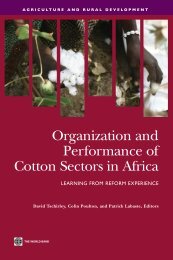Constraints to smallholders participation in Cassava value ... - aaacp
Constraints to smallholders participation in Cassava value ... - aaacp
Constraints to smallholders participation in Cassava value ... - aaacp
Create successful ePaper yourself
Turn your PDF publications into a flip-book with our unique Google optimized e-Paper software.
Consideration should be given <strong>to</strong> explor<strong>in</strong>g secondary data: it is assumed that there are nationalfarm household survey data with<strong>in</strong> Zambia that will enable researchers and stakeholders addresssome of our basic questions about smallholder potential. Given such basel<strong>in</strong>e resources, primarydata collection can be directed <strong>to</strong> other areas of Zambia <strong>to</strong> enable the generalisations and policyformulation at which this report can only h<strong>in</strong>t:• <strong>participation</strong> <strong>in</strong> the process of strategy development and implementation• propensity of <strong>smallholders</strong> <strong>to</strong> respond <strong>to</strong> sec<strong>to</strong>ral <strong>in</strong>itiatives• smallholder-level organisation <strong>to</strong> meet the demands of commercialisation• possible f<strong>in</strong>ancial mechanismsAttitud<strong>in</strong>al issues, and what has come <strong>to</strong> be referred <strong>to</strong> as ‘unobservables’, which are not normallycaptured <strong>in</strong> socioeconomic research need further <strong>in</strong>vestigation, probably through qualitativeapproaches. Besides household socioeconomic data such as resources or livelihood assets and theexternal opportunity and constra<strong>in</strong>t set, more knowledge is needed concern<strong>in</strong>g personal attitudes,aptitudes and attributes which may be important <strong>in</strong> determ<strong>in</strong><strong>in</strong>g farmers’ responses <strong>to</strong> new<strong>in</strong>centives (Poole, N.D. 2000). Fundamentally, do farmers want <strong>to</strong> grow cassava? At whom should<strong>in</strong>terventions be targeted?At the same time, consideration needs <strong>to</strong> be given <strong>to</strong> the ethical issues associated with the target<strong>in</strong>gof <strong>in</strong>terventions, which is normally justified by economic criteria rather than other moral criteria.This <strong>to</strong>pic is very much under-researched.Rural tradersMuch more needs <strong>to</strong> be learnt about the role of small scale traders who are much maligned but alsoact as such important players <strong>in</strong> traditional African market systems. Small scale traders are likely <strong>to</strong>have an important role <strong>in</strong> the bulk<strong>in</strong>g and delivery of cassava <strong>to</strong> <strong>in</strong>termediary processors andmanufacturers. Traders can also be channels of <strong>in</strong>puts, market and technical <strong>in</strong>formation and f<strong>in</strong>ance<strong>to</strong> producers, and can be <strong>in</strong>fluential <strong>in</strong> propagat<strong>in</strong>g and uphold<strong>in</strong>g standards and grad<strong>in</strong>g systemsand product quality control.F<strong>in</strong>anceThe second area of action and participative research is <strong>to</strong> identify and implement new modelf<strong>in</strong>ancial delivery mechanisms: new knowledge and evidence is needed <strong>to</strong> design appropriatef<strong>in</strong>anc<strong>in</strong>g mechanisms, particularly for delivery of small-scale funds <strong>to</strong> grassroots organisations:micro-fund<strong>in</strong>g maybe up <strong>to</strong> $10000 for <strong>in</strong>frastructure for an <strong>in</strong>dividual process<strong>in</strong>g plant. Privatesec<strong>to</strong>r bus<strong>in</strong>ess service firms (such as accountants) can be <strong>in</strong>vited by national banks and<strong>in</strong>ternational f<strong>in</strong>ancial organisations <strong>to</strong> design and implement models of competitive tender<strong>in</strong>g andchallenge fund approaches for micro-enterprise development.Similarly, private <strong>in</strong>ves<strong>to</strong>rs or ‘philanthrocapitalists’ can be <strong>in</strong>vited <strong>to</strong> participate <strong>in</strong> micro-equityfunds will<strong>in</strong>g <strong>to</strong> <strong>in</strong>vest <strong>in</strong> such enterprises. Substantial experience <strong>in</strong> Asia suggests that group lend<strong>in</strong>goffers particularly good prospects for generat<strong>in</strong>g rural enterprises. Such an approach is a means ofcapitalis<strong>in</strong>g forms of collective enterprise for rural process<strong>in</strong>g based on rural organisations such asKWCP which are most likely <strong>to</strong> be community-based, or founded around some other collective entityor ideal like local faith organisations.24
















